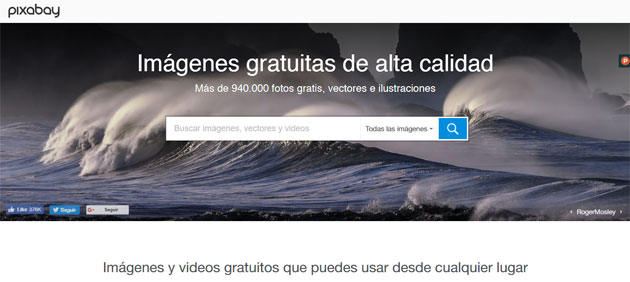
Stock images are critical for your marketing strategy, it doesn’t matter if you have a company or a personal blog. You want to work with good images and improve visibility to your website, right?
This means that you need a content that is very original, so you can show to your visitors that your company is different from your competitors.
A very elaborate visual content is fundamental to improve the image of your company or business. Backgrounds, infographics, illustrations, cards, memes, help create the visual identity of your brand, allowing users to recognize and differentiate your company from other similar brands.
In this sense, there are different stock image systems on the market, offering free and paid files, where you will find, certainly, the perfect help to create and enhance the image of your brand.
So if you need professional images, but you don’t have the necessary resources to invest in a photographer, I recommend that you keep reading, because today we are going to talk about several important details about different stock images.
- 1 What are stock images?
- 2 How can I find stock images?
- 3 ►Free stock images
- 4 ►Paid stock images
- 5 ►Other options: videos, GIFs and audios
- 6 Some recommendations when using stock images
- 7 How to decrease the size of the images you will upload in your newsletter?
- 8 How to upload images for your newsletter with Mailrelay
What are stock images?
Stock images are files that you can buy and download on specialized websites.
Usually, these are royalty free stock images, or are offered for non-commercial use. You can use these images in your articles, in the design of your website, your posts on social networks and, of course, in your newsletters.
As explained before, there are stock images of two types: free and paid. The latter will often offer different packages or monthly plans, that is, you can download a certain number ofimages, depending on the plan you have contracted. In the case of free systems, the number of downloads is usually unlimited, although the quality of the material is not usually as high as that of paid stock images.
As for image sizes, usually you will find different options: small, medium, large, for web Or vectors (.psd or .ai), allowing you to work with the files using advanced image editors, depending on your needs.
Another important point to note is the formats of the files which You can download from a stock image. Usually, in addition to these, many times these services also offer other features such as videos, gifs, icons or freebies.
How can I find stock images?
Here’s a review of the different stock image options available on the Internet, depending on the type of content they offer.
►Free stock images
First of all, I’ll talk about free stock images, where you can download and use images for free.
I would like to mention three well known options: Pixabay, Freepik and Unsplash.
Pixabay
Pixabay includes more than 940,000 high-quality files grouped together in three categories: photos, vectors and illustrations.
All available resources are free of copyright under license Creative Commons CC0, which means you can download, modify, distribute and use them for free, even for commercial purposes, which is good if you can’t work with paid images at the moment.

Freepik
Freepik is one of the popular vector graphics for vectors, PSD and icon files.
On its platform, you can find different types of content and formats: backgrounds, logos, cards, infographics, banners, brochures, etc.
Freepik is known for offering creative and colorful designs, which always ensures very satisfactory results.
Please note that this platform has two versions: A free version for certain features and another paid, for unlimited access to the stock images.
Unsplash
Founded three years ago, Unsplash has become a community of high quality photos. Their photos are available with Copyright using the Creative Commons license, which means they can be used for free.
On the platform, in addition to beautiful photographs, they also offer collections of images, where you can find the best option for your marketing strategy.
►Paid stock images
If you prefer not to work with free images, we will talk about paid options. In this sense, we will talk about some of the best known options:
123RF
123RF has more than 77 million royalty free images. It also includes other sections with different contents, such as videos, icons, banners, vectors, infographics and audios.
It stands out due to the following characteristics:
- It offers a search engine that allows you to find files based on keywords. It also allows you to send any image that you have on your computer to find similar material in the platform in a simple way.
- It also offers its own image editor, allowing you to manipulate your images before downloading the files.
- The speed and security of downloading the images are a plus when deciding to work with this system.
As for its plans and fees, it offers different options:
Packages (with 5 or 25 images) subscription plan (per month or year) and purchase of images based on credit (20, 40, 90, 200, etc.).
Shutterstock
Shutterstock offers more than 125 million files: images, videos, audio, icons, vectors and illustrations.
The files are classified based on different themes: abstract, animals, nature, beauty, fashion, business, sports, etc.
As for fees, they offer three different plans: Basic, professional and Team.
Fotolia
Fotolia is a stock image owned by Adobe and has over 80 million free pictures, vectors, illustrations and videos all royalty free.
In terms of its rates and prices, it has three options:
Credits, monthly packages and subscription fee with daily quota.
►Other options: videos, GIFs and audios
In addition to the stock images just mentioned, there are other sites on the internet where you can find different resources, such as videos, GIFs and audios.
- Websites where you can find videos. Some pages where you can find videos are: Mazwai, VideoHive, Coverr, Life of vids, Videvo, Videezy or Distill.
- Pleases for downloading gifs. The best known of all is Giphy, but there are also others, such as the gif collector, Vaya gif or Tumblr.
- Sites where you can download audios. Some websites where you will be able to download high quality audios are: Jamendo, SoundBible, FlashKit or Free Music Archive.
Some recommendations when using stock images
Although these images are a very useful feature, you should take into account a number of considerations before using this type of system:
- Don’t overdo it. The reality is that these images are not all 100% “real”. That is, if you have a company and an “about us” page, if you use a file from one of these websites, the result will not be as realistic as if you were using an image of the members of your team.
- Always try to use the same type of images. If you decide to use these images, on your site or blog, my advice is to use always the same type of image to follow an uniform line.
- Add a personal touch to your images. So that the images don’t look so “unreal”, we recommend following these tips: You can apply a filter or effect in Photoshop to use your corporate colors, add a watermark or include your logo on the images you will be using.
When you work with images on your website or blog and also when you want to include these files in your newsletter, we always recommend that you select high-quality images. Remember that images are a feature that can help convince the user to visit your website, so he will remember your brand.
In this sense, the best option is to use images that are of good quality, but the major drawback of this strategy is the size of these files, which will increase download and upload time.
Therefore, you should prepare your images before uploading them to your website or for your newsletter, in order to reduce its size, but maintaining its quality.
So I’m going to list a number of tools and resources which you can use to compress your images.
Photoshop
If you use Adobe Photoshop to work with your images, you should know that there is an option to save images in web format, with the correct resolution for the size you need, but with a smaller file.
The “save to web” process in Photoshop is as follows:
- You should open the image on your computer. In the “File” menu, you can select the “save to web” option or use the following combination on your keyboard: Alt + Shift + Ctrl + S
- Next, a window will open where you can select some parameters to save your image: file name, format (.jpg, .png, .gif), colors or size. The latter is one of the most important aspects.
- The next step is to select the dimensions of the image. The width should not exceed 600px if you will use the file in your newsletter and 900 or 1000px if you are uploading the image to your website or blog. My advice is that you always try to adapt these measures according to your specific needs. When you add the width, the software automatically changes the height.
- Now that your image has already been properly optimized, it’s time to save it to your computer.
Compressor.io
Compressor.io is an online tool that allows you to compress and optimize your images before sending them to a website, blog or newsletter.
This tool supports four different formats (JPEG, PNG, GIF and SVG) and two different formats for compression.
Its operation is very simple. To compress your images, you must follow these steps:
- Click on the “Try it” button and you will see a page like this.
- Here you can select on your computer the image you want to optimize, which will be loaded and automatically compressed.
- When it is done, you will see the size of the image before and after being optimized. Finally, click the “Download your file” button to save the image. If you want to compress other images, you just need to click on “Compress another picture “.
WP Smush
If you use WordPress as a CMS for your website, I recommend installing this free plugin.
WP Smush offers resizing options to optimize and compress all your images without losing quality.
As for its features, this plugin allows you to optimize both the images which are already hosted on your site, as well as the new images you will upload.
Once compressed, you can use the images for your newsletter.
The process for uploading images to your newsletter is quite simple. To do this, just follow these steps:
►When you are editing the newsletter, click “Add Image.”
►In the next screen, you can configure the image: URL, alt text, width, height, border, vertical space and horizontal alignment, and the target link.

►This is where you should add the exact URL of your image to insert it in your newsletter, as well as other properties.

►To capture the URL of an image, you just need to right click on it, selecting the “copy image address” option.
You can do this for both the images that are already published in your site as well as those hosted in your media library on WordPress and have not yet been published.

► Finally, you only need to adjust the other properties (size, border, alignment, etc.), and when it is done, you can use the image for your newsletters.
Now that you know how to work with stock images, and you have information to optimize your images, it’s time to start preparing your marketing strategy and improve the visual appearance of your website and your newsletters.